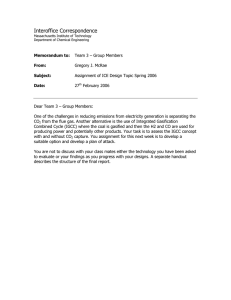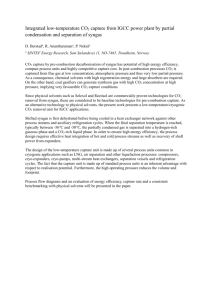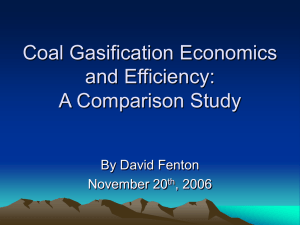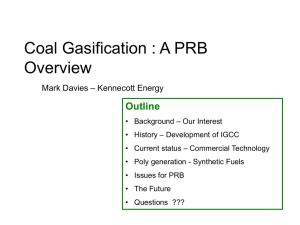Pre-Combustion CO2 Capture - US-China Energy Center
advertisement
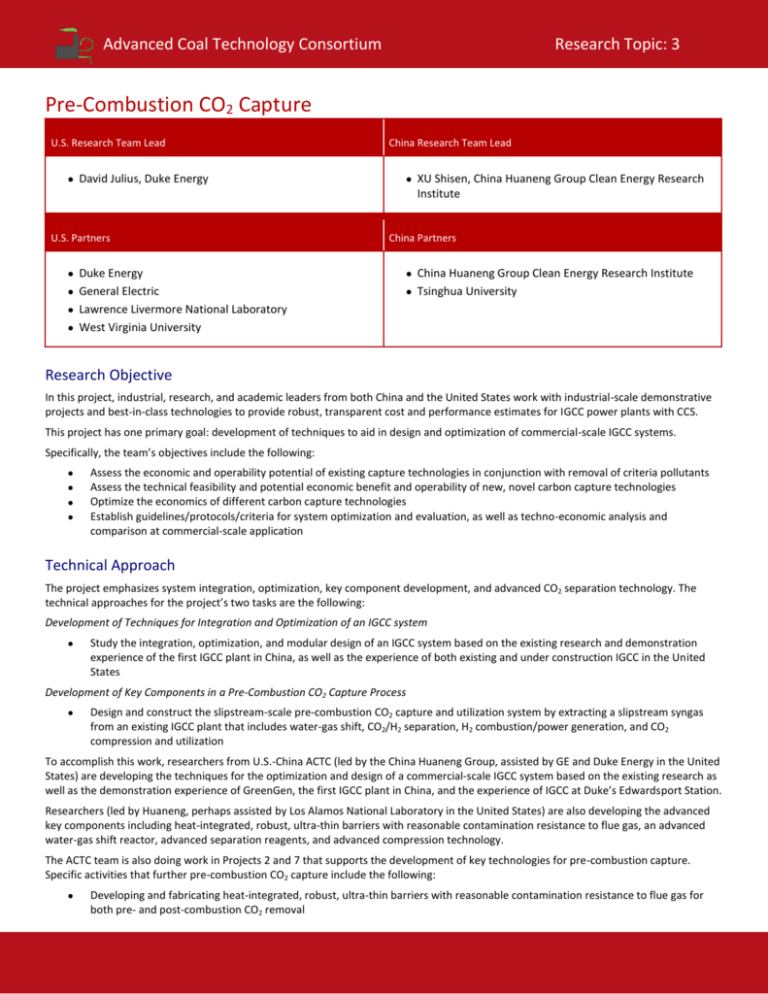
Advanced Coal Technology Consortium Research Topic: 3 Pre-Combustion CO2 Capture U.S. Research Team Lead David Julius, Duke Energy U.S. Partners Duke Energy General Electric Lawrence Livermore National Laboratory West Virginia University China Research Team Lead XU Shisen, China Huaneng Group Clean Energy Research Institute China Partners China Huaneng Group Clean Energy Research Institute Tsinghua University Research Objective In this project, industrial, research, and academic leaders from both China and the United States work with industrial-scale demonstrative projects and best-in-class technologies to provide robust, transparent cost and performance estimates for IGCC power plants with CCS. This project has one primary goal: development of techniques to aid in design and optimization of commercial-scale IGCC systems. Specifically, the team’s objectives include the following: Assess the economic and operability potential of existing capture technologies in conjunction with removal of criteria pollutants Assess the technical feasibility and potential economic benefit and operability of new, novel carbon capture technologies Optimize the economics of different carbon capture technologies Establish guidelines/protocols/criteria for system optimization and evaluation, as well as techno-economic analysis and comparison at commercial-scale application Technical Approach The project emphasizes system integration, optimization, key component development, and advanced CO2 separation technology. The technical approaches for the project’s two tasks are the following: Development of Techniques for Integration and Optimization of an IGCC system Study the integration, optimization, and modular design of an IGCC system based on the existing research and demonstration experience of the first IGCC plant in China, as well as the experience of both existing and under construction IGCC in the United States Development of Key Components in a Pre-Combustion CO2 Capture Process Design and construct the slipstream-scale pre-combustion CO2 capture and utilization system by extracting a slipstream syngas from an existing IGCC plant that includes water-gas shift, CO2/H2 separation, H2 combustion/power generation, and CO2 compression and utilization To accomplish this work, researchers from U.S.-China ACTC (led by the China Huaneng Group, assisted by GE and Duke Energy in the United States) are developing the techniques for the optimization and design of a commercial-scale IGCC system based on the existing research as well as the demonstration experience of GreenGen, the first IGCC plant in China, and the experience of IGCC at Duke’s Edwardsport Station. Researchers (led by Huaneng, perhaps assisted by Los Alamos National Laboratory in the United States) are also developing the advanced key components including heat-integrated, robust, ultra-thin barriers with reasonable contamination resistance to flue gas, an advanced water-gas shift reactor, advanced separation reagents, and advanced compression technology. The ACTC team is also doing work in Projects 2 and 7 that supports the development of key technologies for pre-combustion capture. Specific activities that further pre-combustion CO2 capture include the following: Developing and fabricating heat-integrated, robust, ultra-thin barriers with reasonable contamination resistance to flue gas for both pre- and post-combustion CO2 removal Formulating new CO2 absorbents with chemical additives for pre- and post-combustion CO2 capture with high capacity, fast kinetics, and high stability Initializing models for existing pre-combustion capture technologies, chiefly physical sorbents, both as individual models and within the two reference plants (including water-gas shift and gas cleanup) Recent Progress Duke Energy’s Edwardsport plant and Huaneng’s GreenGen IGCC are under construction or in commissioning stage. Knowledge sharing of engineering data has begun; major knowledge sharing of start-up and operational lessons will occur once the plants are online and operational data are available (2013–2014). Expected Outcomes Key outcomes include critical data, lessons, and knowledge shared through operational experience with demonstration projects as systems are optimized and the cost of pre-combustion CO2 capture is lowered. Such knowledge sharing contributes to accelerating the development of IGCC with CCS, a critical pathway toward low-carbon power generation with coal. An integrated gasification combined cycle power plant with carbon capture and storage
